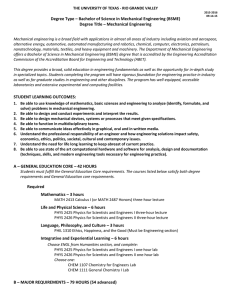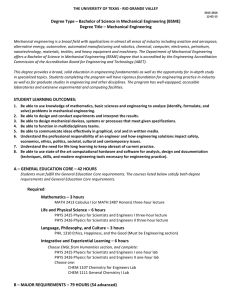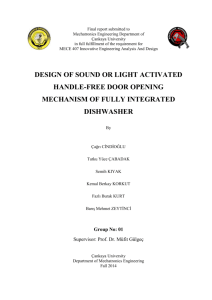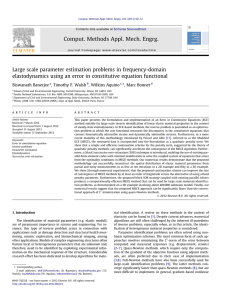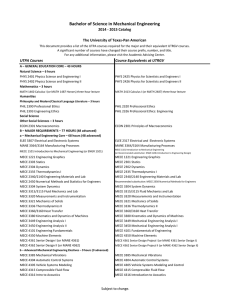MECE E3018 LAB REPORT TEMPLATE
advertisement
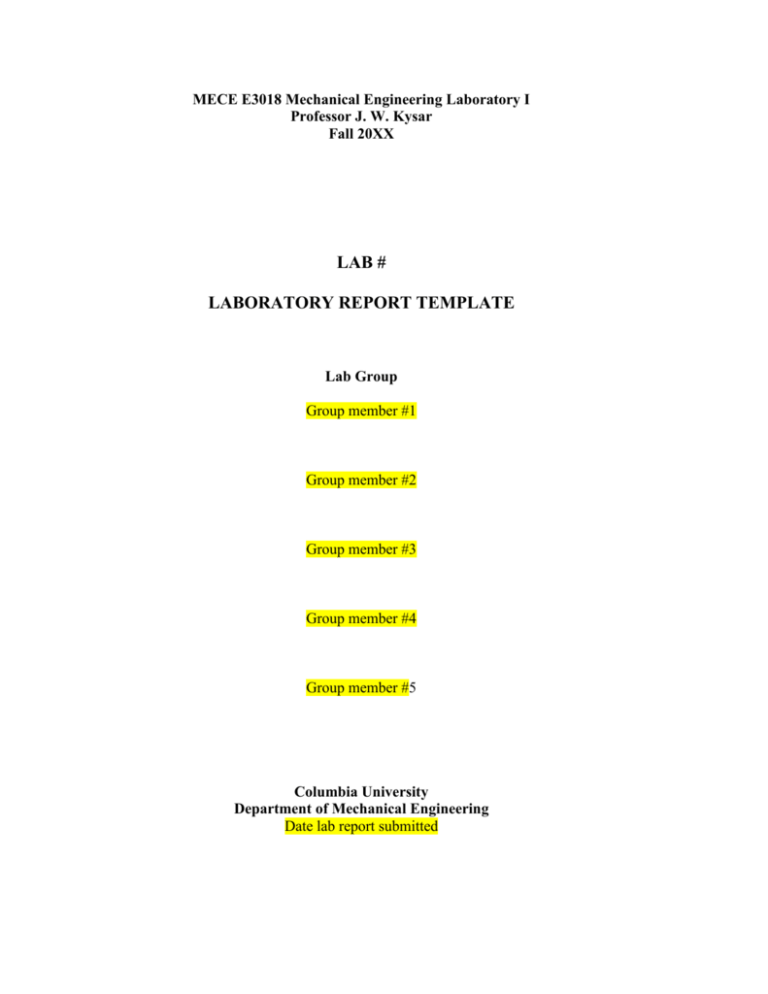
MECE E3018 Mechanical Engineering Laboratory I Professor J. W. Kysar Fall 20XX LAB # LABORATORY REPORT TEMPLATE Lab Group Group member #1 Group member #2 Group member #3 Group member #4 Group member #5 Columbia University Department of Mechanical Engineering Date lab report submitted ABSTRACT This should be a one paragraph summary of your entire report. This means that everything from your objectives to results should be briefly addressed. A good abstract also briefly discusses the significance of the results. TABLE OF CONTENTS To insert Table of Contents, go to Insert/Index and Tables …/ Table of Figures. Choose Formal style. Choose Figures caption label. If sections need to be added to (or deleted from) the table of contents, apply the Heading 1 style to the section title within your text. Then update the TOC by selecting it with the mouse and using the right button. Select “!update field.” 1. INTRODUCTION .........................................................................................................................................3 2. THEORY .......................................................................................................................................................3 2.1 Equations derivation and descriptions. .......................................................................................................3 2.2 Operation of a Wheatstone bridge. .............................................................................................................4 3. APPARATUS .................................................................................................................................................4 4. APPROACH ..................................................................................................................................................4 5. RESULTS.......................................................................................................................................................4 5.1.1 Soda can experiment. ........................................................................................................................5 5.1.2 Cantilever beam experiment. ............................................................................................................5 6. DISCUSSION ................................................................................................................................................6 7. CONCLUSIONS............................................................................................................................................7 8. ACKNOWLEDGEMENTS ..........................................................................................................................7 9. REFERENCES ..............................................................................................................................................8 10. APPENDICES ...............................................................................................................................................8 To insert table of contents, go to Insert/Index and Tables …/ Table of Contents. Choose Formal style. MECE E3018 Fall 2005 1 3/9/2016 LIST OF FIGURES FIGURE 1 HYSTERESIS CURVES ........................................................................................................ 7 To insert List of Figures, go to Insert/Index and Tables …/ Table of Figures. Choose Formal style. Choose Figures caption label. LIST OF TABLES TABLE 1 LIST OF APPARATUS ................................................... ERROR! BOOKMARK NOT DEFINED. TABLE 2 SODA CAN DIMENSIONS AND MATERIAL PROPERTIES ......................................................... 5 TABLE 3 MEASURED VALUES FOR THE STRAINS ............................................................................... 5 TABLE 4 CANTILEVER BEAM DIMENSIONS........................................................................................ 5 TABLE 5 STRAIN MEASUREMENTS. ................................................................................................... 6 TABLE 6 CALCULATED VALUES FOR YOUNG'S MODULUS AND POISSON'S RATIO ............................. 6 TABLE A1 – LIST OF … .................................................................................................................... 9 TABLE A2 – LIST OF … .................................................................................................................... 9 To insert List of Tables, go to Insert/Index and Tables …/ Table of Figures. Choose Formal style. Choose Tables caption label. MECE E3018 Fall 2005 2 3/9/2016 1. INTRODUCTION This section is an introduction to the lab objectives and its practical uses. It should normally be 2 to 3 paragraphs. The primary functions are to capture the interest of the reader and describe the objectives of this laboratory exercise. The section needs to introduce the lab function and background. Any new concepts and terminology need to be given as well. Last should be the objectives of the lab. Include what should be accomplished or learned through performing this experiment. 2. THEORY Explain all new concepts covered in this experiment. Most labs will cover at least two concepts: a physical measurement system, such as a thermocouple, and an analysis tool, such as the linear regression. All non-trivial equations must be given here with explanations for all variables. Values for constants, such as material properties, are also given in this section. To create an equation, click on Insert/Object and then open up “Microsoft Equation 3.0” Equations should be center justified, with the equation number in parentheses right justified. Use the ‘Equation’ style to achieve this result. 2.1 F ma (1) E mc2 (2) Equations derivation and descriptions. Explain how the equations for your experiment were determined. This can be based on the derivations done in class. Include explanations of all equations and variables (bending stress, moment of inertia, Young’s modulus). What assumptions must be made to use the equations from class for this experiment? For the soda can experiment give the equation for longitudinal MECE E3018 Fall 2005 3 3/9/2016 and transverse stress (Hoop stress), and explain how pressure can be calculated using the stress equations. You can input an equation into a Word document from the “Insert” menu, followed by the “Object” option and then by choosing the object type to by “Microsoft Equation”. 2.2 Operation of a Wheatstone bridge. Explain the operation of a Wheatstone Bridge. Include the equation for output as a function of excitation voltage and strain for the type of bridge used in this experiment. 3. APPARATUS Provide a narrative describing all the equipment used in this lab. Keep only the items that apply to your experiment. It is sometimes desirable to list equipment in at table. 4. APPROACH Describe the procedure that was used in performing this lab. This section should give a narrative of what was done, with sufficient details to allow another investigator to fully understand what was done, and to reproduce it independently. If steps were done differently than originally planned, intentionally or by error, describe the changes. The description of the procedure should include enough detail to allow the experiment to be reproduced independently, without your intervention or verbal clarification. 5. RESULTS What are the results of the experiment? Most results will fit into tables or figures. Describe all tables and figures in the text, repeating important information as needed. Raw data can often be put in an appendix, but its description and interpretation should be given here. If there are large tables, or a large number of tables and figures, put them into an appendix and MECE E3018 Fall 2005 4 3/9/2016 provide a summary in this section to show the overall results and identify the trends. All data, except the original raw values, must be converted to consistent units. All data must include the uncertainty values with explanation of how they were determined. 5.1.1 Soda can experiment. Calculate the internal pressure of the can using the result of each strain gage (use the equations for thin-walled pressure vessels). List the values used for aluminum properties and give a reference to the source Table 1 Soda can dimensions and material properties Parameters Diameter [m] Thickness [m] Young’s modulus [GPa] Poisson’s ratio Soda can Table 2 Measured values for the strains long [-strain] transv [-strain] 5.1.2 Cantilever beam experiment. Give calculated values of the modulus of elasticity and Poisson’s ratio. Find a reference to a similar material and compare the results Table 3 Cantilever beam dimensions Parameters Width [m] Thickness [m] Length [m] Strain gauge location [m] Beam MECE E3018 Fall 2005 5 3/9/2016 Table 4 Strain measurements. long [-strain] Mass [g] 1 2 3 transv [-strain] Average 1 2 3 Average 100 Loading 200 300 400 Unloading 400 300 200 100 Table 5 Calculated values for Young's modulus and Poisson's ratio Young’s modulus [GPa] 6. Poisson’s ratio DISCUSSION Analyze trends in the data. Explain what was found and how it can be used in the future. Quantify and describe the sources, or suspected sources or error and uncertainty. Evaluate the convergence between the theory and experiment. Does the experiment confirm the theory? If not, what could be the cause of differences? If the lab could be repeated, how should the procedure be changed to improve the results? For the soda can experiment: Compare the results and explain any difference. Was the strain on the indicator positive or negative? Why? State if the internal pressure you calculated makes sense. MECE E3018 Fall 2005 6 3/9/2016 For the beam experiment: there should be a linear relationship between load and output (strain). Quantify how well your data followed this pattern. Include linearity, precision, and hysteresis in the discussion. Plot the hysteresis curves for loading and unloading for both strain gauges Unloading Loading Force [N] Force [N] Unloading Displacement, long [-strain] Loading Displacement, transv [-strain] Figure 1 Hysteresis curves 7. CONCLUSIONS This section is normally brief, consisting of 1 or 2 paragraphs. Refer to the objectives of the lab, and articulate whether of not they were met, and how. If some objectives were not met, give a brief explanation of why. Explain what was found or learned by performing this lab. Any ideas for improving the lab can also be included in this section. 8. ACKNOWLEDGEMENTS This is a chance for you to acknowledge the people who helped you complete your project. MECE E3018 Fall 2005 7 3/9/2016 9. REFERENCES References are those bibliographical sources that are directly referenced in the text. Make sure all references are complete, including page numbers. When you cite one of these sources in your text, place the last name of the author and the date of publication, separated by a comma, in parentheses after the quotation. Example: (Smith, 1989) or, if you mention the author in your text, then: Smith (1989). With more than two authors, just use the first author and then “et al”: (Beckwith, et al., 1993). Write the list of references in the format shown below using the ‘Ref’ style. BECKWITH, MARRANGONI, and LIENHARD. (1993) Mechanical Measurements. 5th edition. Reading, MA: Addison-Wesley, 1993, pp 45-63, 79-91, 98-108 BEER, David; MCMURREY, David. (1997) A Guide to Writing as an Engineer. New York : John Wiley & Sons, Inc., 1997, pp 1-246 10. APPENDICES This section is optional. If there are large amounts of raw data, or a large number of graphs, summarize them in the Results section and put the bulk of them here. (In most cases, only raw data will find its way here). All contents of the appendices must be referenced from within the text. Remember that the contents of an appendix is not normally examine in details, unless there is a question with something in the Results section and the reader wants to viewed the raw data given in the Appendix. However, the format of the data presented in the Appendix must follow the format imposed on the rest of the report. This includes margins, table and figure numbers, captions, and organization. Tables and figures presented in the Appendix must be also included in the list of figures and tables. However, start their numbering afresh, using the prefix A, e.g., Figure A1, MECE E3018 Fall 2005 8 3/9/2016 Figure A2, …; Table A1, Table A2, …If you want to take advantage of automatic numbering, you can use the codes below to restart the automatic numbering (The code A1 has been modified to restart from 1.) Figure A1 – Detail of … Figure A2 – View of … Table A1 – List of … Table A2 – List of … GOOD LUCK WITH YOUR REPORT! Remember, when in doubt, better ask! The TA’s are there to assist you to get the best results possible. MECE E3018 Fall 2005 9 3/9/2016



